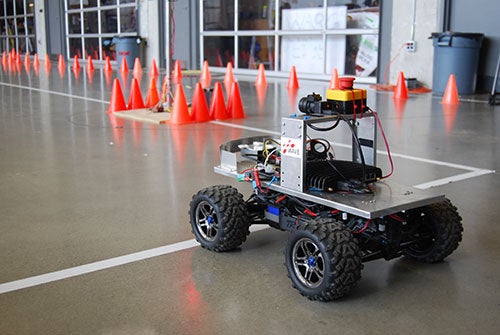
Robot race a training ground in autonomous vehicle technology
Self-driving vehicles compete to win on increasingly complex course

Self-driving vehicles compete to win on increasingly complex course
By Christian Aagaard Marketing and Strategic CommunicationsFour student teams compete Saturday (July 18) in a parking lot beside Engineering 5 to see which one of them has the better road-ready, quick-thinking, robot.
They are participating in IARRC — the International Autonomous Robot Racing Challenge — an event Waterloo’s engineering students started 10 years ago. This year’s competition brings together teams from the University of Waterloo, Waterloo Collegiate Institute, the University of Western Ontario and Georgia Institute of Technology based in Atlanta, Ga.

"It’s an excellent training ground,” says organizer Steven Waslander. "The students are buying stuff off the shelf and using open-source code, and they’re getting training in autonomous vehicle control.”
All of which, he adds, primes them for study and work in the field of autonomous technology for larger vehicles. This covers self-driving vehicles, and — an area of expertise at Waterloo — systems that collect and use traffic data independent of any action on the part of a driver.
An associate professor in Waterloo’s Department of Mechanical and Mechatronics Engineering, Waslander heads the Waterloo Autonomous Vehicles Laboratory. Robots at the competition get faster and smarter every year, he says. Lessons learned at IARRC have worked themselves into mechatronic courses at Waterloo.
“The first year, we had vehicles follow a line, but that got too easy,” Waslander says. “Then we switched to cones, and that got too easy.”
The competition has grown to feature two components: a drag race, and a circuit that throws in a number of obstacles to test how well the robots read and react to changes in their surroundings.
Teams build their battery-powered models on chassis about the size of a small pizza box. A 30-centimetre traffic light starts each heat, and the robots use laser scanning to “see” the way ahead, navigating across intersections, over ramps and around competing vehicles.
A shortcut on the circuit this year requires the robots to cross a section of grass and pass through a tunnel.
Aside from start and finish, there isn’t much in the way of human control in the competition. The robots move about autonomously, earning points on timing, or losing them in collisions. The skill lies not in the operation of a joystick, but in the laser and optical technology students hack and pack into the robot.
This year, Waterloo engineers are gritting their teeth for a rematch with colleagues from Georgia Tech, which won the event in 2014. Open to the public, IARRC drew about 150 people last year. It begins at 11 a.m.
“All kinds of future University of Waterloo students come out to watch, which is really great,” Waslander says.

Read more
3D printing technology is perfect fit with new Waterloo Institute for Sustainable Aeronautics

Read more
Waterloo lab helps fill industry demand for additive manufacturing skills

Read more
Combining machine learning techniques with real-world scenarios to combat forest fires
The University of Waterloo acknowledges that much of our work takes place on the traditional territory of the Neutral, Anishinaabeg, and Haudenosaunee peoples. Our main campus is situated on the Haldimand Tract, the land granted to the Six Nations that includes six miles on each side of the Grand River. Our active work toward reconciliation takes place across our campuses through research, learning, teaching, and community building, and is co-ordinated within the Office of Indigenous Relations.